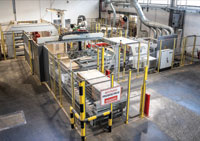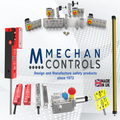
Posted to News on 24th Apr 2019, 00:00
Digital twin drives design optimisation
When a parquet flooring manufacturer sent in an enquiry for a fully automated floorboard production line, engineers at machine builder Willingshofer recognised that a new approach to design would be required.

Located in a remote valley in south eastern Austria, Willingsdorfer has been meeting the needs of customers since 1908. Established as a blacksmith, the company shifted its focus in the 1980s from agricultural to industrial customers, and is now a leader in designing and manufacturing industrial equipment.
An enquiry for an automated floorboard production line pushed Willingshofer to look at a new approach to design. The customer’s plant processes large panels of high-density fibreboard (HDF) and various types of wood. After priming, a saw cuts out boards in 15 different sizes ranging from 370x100mm to 1,800x180mm. These go through the varnishing booth and are subsequently structured before finally reaching a stacker.
The plant is designed to produce up to 360 boards per minute. “Between the processing stations, they travel at speeds of 20 to 100 metres per minute, depending on their size,” says Johannes Huber, design engineer at Willingshofer. “Traditional manipulators or industrial robots are clearly too slow, so we had to rely on ballistics where the material flow needs to be redirected or split up.”
In this scenario, gravitational and centrifugal forces considerably influence the boards’ kinematics behaviour. At the given output rate, one out of 1,000 boards taking the wrong fork would statistically mean more than 20 mishaps per hour. This would not be acceptable.
“Making the required calculations goes far beyond the capabilities of mental arithmetic and spreadsheets,” says Reinhard Poelzl, design engineer at Willingshofer. “Consequently, we started looking for a tool to help us verify and optimise our designs for predictable results using a digital twin of the production line.” A demonstration of Mechatronics Concept Designer from Siemens PLM Software at a trade show proved to be a game changer.
The easy-to-use modeling and simulation capabilities enable the user to quickly create and validate alternative kinematic design concepts early in the development cycle. Unlike a model-based tool, Mechatronics Concept Designer allows you not only to see what the design looks like, but validate that it works. For the flooring production line, this enabled Willingshofer engineers to evaluate several material transfer concepts involving pushers, a turnstile and lifting mechanisms before deciding to adopt a purely ballistic concept.
The Willingshofer design engineers used Mechatronics Concept Designer to import assemblies from Solid Edge. They omitted unnecessary details to simplify the models, then enriched the models with physical properties, such as joints, motion, collision behavior and friction coefficients for each component.
“Creating digital twins of the machinery was easy using predefined values provided by a re-use library within the Mechatronics Concept Designer,” says Poelzl. “For the transported wood as an inhomogeneous, natural material, however, we had to determine a range of friction coefficient values experimentally.”
Huber adds: “Unlike other model-based tools, Mechatronics Concept Designer allows you not only to see what it looks like, but validate that it works before building a prototype. We actually dismissed designs that were not sufficiently tolerant to irregularities in upstream processes.”
Extensively testing the digital twins of critical parts of the floorboard production line, the engineers were able to verify the plant’s design. “Mechatronics Concept Designer comes with full CAD functionality so we could quickly make and try out modifications with the software,” says Poelzl. “Feeding back successful design variations to Solid Edge with full associativity took a matter of seconds.”
The software enabled Willingshofer to optimise the design over several iterations for maximum productivity and uptime without first building hardware. Huber comments: “As we had verified all dimensions and transport speeds using the digital twin, our choice of components, such as motors and gears, was decisive very early in the development process.” Prior to shipping the production line to the customer, the Willingshofer engineers performed extensive in-house tests. These revealed that all the predictions derived from testing the digital twin in the Mechatronics Concept Designer were so precise that only minor adjustments were required. This greatly reduced the time required for commissioning. It enabled the customer to easily achieve the goal of replacing the existing plant during a three week closure.
For Willingshofer, the most significant benefit of using the Mechatronics Concept Designer is getting it right the first time. “Without Mechatronics Concept Designer, we would not have been able to deliver predictable results,” says Siegfried Willingshofer, co-owner and CEO. “This enabled both our customer and us to sleep better knowing there would be no surprises.”
Siemens Industry Software Limited
Brunel House,
Sir William Siemens Square
GU16 8QD
UNITED KINGDOM
01276 413200


















